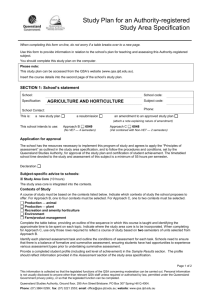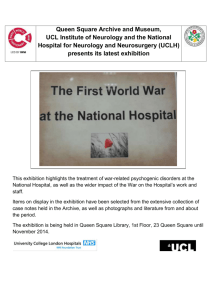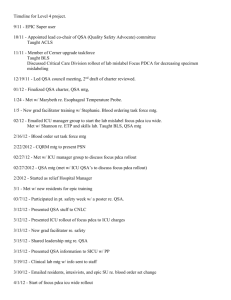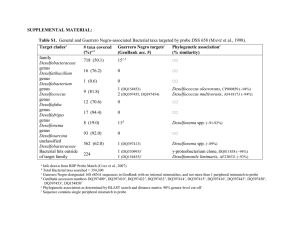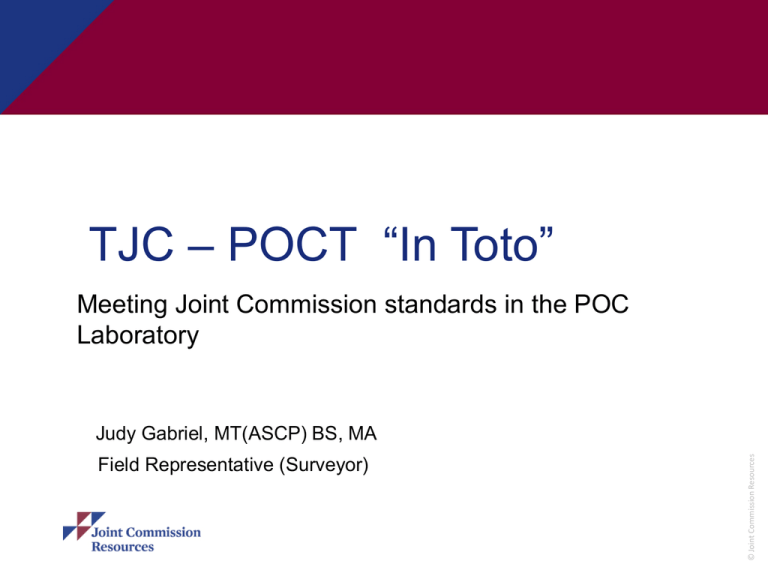
TJC – POCT “In Toto”
Meeting Joint Commission standards in the POC
Laboratory
Field Representative (Surveyor)
© Joint Commission Resources
Judy Gabriel, MT(ASCP) BS, MA
Objectives
Understand what standards are applicable to your
setting
Learn common unmet standards
Review resources for compliance
Introduce applicable new standards that take effect
July 2011
ask
© Joint Commission Resources
Get answers to the questions you’ve been eager to
© Joint Commission Resources
Toto, the reality finder
Which of the standards apply to MY laboratory
What is a laboratory?
– Any location that performs laboratory testing for
patients
– Does not apply to employee health
– Be careful about drug testing in a substance abuse
setting or for forensic purposes only
Waived testing only: mostly WT chapter standards,
PPMP and non-waived: all chapters
© Joint Commission Resources
but EC or IC could apply and NPSG certainly
Frequently cited standards in Waived Chapter
WT.05.01.01: The org maintains records for WT.
– EP 1: documentation of QC results
– EP 3: reference ranges are included in the chart
– EP 4: functional audit trail of patient result &
associated QC results
WT.01.01.01: P/P written, approved, followed
© Joint Commission Resources
– manufacturer instructions are followed
– Confirmatory testing performed
More WT frequently findings
WT.03.01.01: competency of staff
– Yearly
– Two of four methods documented
•
•
•
•
Blind test
Observation
Monitoring of QC
Written test
© Joint Commission Resources
All but WT.05.01.01 are direct impact EPs
Latest on the cleaning of glucose meters
CDC recommendation:
http://www.cdc.gov/injectionsafety/blood-glucosemonitoring.html
FDA letter to manufacturers 9/30/10 with similar
information
Basically: one time use FS devices; gloves; multiuser
This would be scored under an IC Std if not WT.01.01.01
© Joint Commission Resources
meters clean between patients. Stay tuned for JC FAQ
PPMP or Non-waived Laboratories
All chapters apply
In the QSA chapter only the standards that are general
or specialty specific apply
IMPORTANT: Does the laboratory have its own CLIA
number or is it part of the main laboratory within the
© Joint Commission Resources
organization? This makes a difference.
A POC Laboratory that is part of the main laboratory
Essentially you are a “section” of the main laboratory
and all activities are incorporated in their overall plans
e.g. PI monitors, Policies and Procedures, Reporting
formats.
Be careful about copying procedures from the main
laboratory as they may contain details or instructions that
different from Microbiology instructions.
© Joint Commission Resources
do not apply to you--just like Chemistry instructions are
Non-waived Laboratory that has its own CLIA certificate
Document Control (DC) chapter:
– Written procedures
– DC.01.03.01: maintain the 2 unique identifiers
throughout the whole testing process
© Joint Commission Resources
• Collection of samples (change in July: combined 2 bullets)
• Ordering of tests (new in July: contact info for “user” of test
results + process to get missing order before testing)
• Procedures for each test include 10 elements (if
applicable). New in July: criteria for confirmatory testing.
• NEW standard DC.02.01.03 in July: procedure for test
system down time (could be instrument or no reagent/kit)
More about the DC chapter
DC.02.03.01: report of results in the medical record
– A frequently cited standard
• Name & address of laboratory missing
• Date & time the test resulted missing (availability of the
information is not enough, must be part of the report)
• Units and reference ranges missing
– New in July: report must include sex of the patient
and age or date of birth of the patient.
– Amended report needs to clearly ID the change.
– See also change at QSA.02.12.01 (notify orderer)
© Joint Commission Resources
DC.02.04.01: Retaining records: New in July:
© Joint Commission Resources
Dorothy & Toto
EC & IM Chapters
Lots of Direct Impact EPs in the EC chapter. Mostly
covered for you by the organization, but if you are in a
free standing facility, review to be sure all are covered.
New in July: EPs in EC.02.06.01: eye wash stations
and no food or drink stored in work areas
IM chapter: no changes that affect POCT. But watch
information) Note: this issue requires a written policy
© Joint Commission Resources
out for security of information (back up of computer
HR Chapter
HR Standards:
– Most frequently cited standard has to do with
documented competency. There are six point that
need to be addressed:
Direct observation of patient test performance
Report details
Preliminary reports, worksheets, QC, PT, PM
Direct observation of instrument maintenance
Direct observation of test performance
Problem solving skills
Other challenge is timing: original, 6 mos, yearly
© Joint Commission Resources
•
•
•
•
•
•
IC, LD, NPSG, PI Chapters
IC standards: common sense; nothing new for July
LD standards: NEW for July:
– Written organization plan or chart
– Re-write of EP 1 for LD.04.05.01: change to the
Note: moved from IM chapter the requirement to
have a list of laboratory test methods, performance
specs and interfering factors
PI: nothing new; be sure to have documented projects
© Joint Commission Resources
NPSGs: nothing new, just adhere to 2 unique IDs
QSA Chapter (Quality System Assessment)
QSA.01…standards (5 of them):
– 2 require written procedures
– Include regulated and non-regulated analytes
– Require comprehensive investigation of all scores
less than 100%
– Require testing material like & with patient samples
– Require rotating among staff
No changes in July 2011
© Joint Commission Resources
These are on the most frequently cited standard list
More QSA
QSA. 02…(14 separate standards with LOTS of EPs
– Validation of new test or new equipment (this
includes loaner equipment)
– Calibration verification aka reportable range
validation. This is a most frequently cited standard.
It is wise to also check the 2 EPs elsewhere that
say the laboratory does not report outside of their
validated range. I give this frequently for low level
patient pO2s. Watch out for ACT & oximeter
instruments; this standard includes them.
© Joint Commission Resources
These standards include:
– The standard about instruments that have
equivalent QC: the validation of and requirement
for external QC. This is most often not done well for
Blood Gas instruments. This also applies for nonwaived, non-instrument based tests.
– The standards about QC and the acceptable ranges
for QC material
– The standard about correlation of instruments,
methods or locations for testing the same analyte.
NEW in July: define target values and tolerance
limits for the correlation
– NEW in July: Changed results: notify orderer
© Joint Commission Resources
More of what the QSA.02…include
The rest of the story
The rest of the changes effective July 2011 involved
specialties that would not be done as POCT.
The standards in the QSA chapter besides those
already mentioned are generally in the Chemistry
(QSA.06…), Urinalysis (QSA.07…), Hematology
© Joint Commission Resources
(QSA. 11…), PPMP (QSA.18…) or the Waived chapter.
REFERENCES
CAMLAB: full standard book
2011 Laboratory Accreditation Overview Guide
TJC web site
– Accreditation –Laboratory
– Standards—FAQs
© Joint Commission Resources
The PPR product
© Joint Commission Resources
???QUESTIONS???

